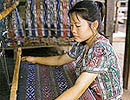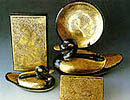 |
Best
of Thailand |
| Craft |
 |
 During
1976, Her Majesty Queen Sirikit established the Foundation for the Promotion
of Supplementary Occupations and Related Techniques (SUPPORT), with the
objective of giving rural Thais alternative sources of income and also
for reviving some of the kingdom's traditional crafts. The result has
been a variety of beautiful items available in Thailand through a chain
of outlets called Chitrlada Shops. There are five such shops in Bangkok
alone while others can be found in Nakhon Pathom province and Chaing Mai. During
1976, Her Majesty Queen Sirikit established the Foundation for the Promotion
of Supplementary Occupations and Related Techniques (SUPPORT), with the
objective of giving rural Thais alternative sources of income and also
for reviving some of the kingdom's traditional crafts. The result has
been a variety of beautiful items available in Thailand through a chain
of outlets called Chitrlada Shops. There are five such shops in Bangkok
alone while others can be found in Nakhon Pathom province and Chaing Mai.
Among the SUPPORT
products to be found in these shops are hand-woven silks from the northeast,
elegant "Yan Liphao" handbags, made from vine that grows in the south
often adorned with gold fittings, jewelry in distinctive designs, supple
Thai cotton in classic patterns and numerous moderately priced souvenirs.
All funds raised from the sale of these crafts go to the SUPPORT project.
Textile
 Hand
woven textiles are typical of traditional rural communities, and the craft
flourishes in the northeast. The most famous fabric of the region is "Mat
Mee" silk with production centered in Khon Kaen where there is a week-long
annual silk festival in early December. Unlike other kinds of Thai silk,
"mat mee" is made from tie-dyed yarn, which permits the weaver to work
distinctive, multicolored patterns into the design. Truly a silk of rare
distinction! Hand
woven textiles are typical of traditional rural communities, and the craft
flourishes in the northeast. The most famous fabric of the region is "Mat
Mee" silk with production centered in Khon Kaen where there is a week-long
annual silk festival in early December. Unlike other kinds of Thai silk,
"mat mee" is made from tie-dyed yarn, which permits the weaver to work
distinctive, multicolored patterns into the design. Truly a silk of rare
distinction!
Nielloware
 This
is where a dark amalgam of lead, copper and silver metals is rubbed into
etched silver. The craft was introduced to the south from India and then
spread to the north. Nielloware is used to decorate trays, betel boxes,
vases, and other small objects. This
is where a dark amalgam of lead, copper and silver metals is rubbed into
etched silver. The craft was introduced to the south from India and then
spread to the north. Nielloware is used to decorate trays, betel boxes,
vases, and other small objects.
Lacquerware
 Very
Oriental and very attractive, lacquerware is a craft special to Chiang
Mai and the north. An art dating back from the Ayutthaya period, 3 layers
of lacquer from the sumac tree are brushed onto a wood or wicker based
and each layer is polished with charcoal. Then a fourth layer is added
and once more highly polished with charcoal. For a finishing touch, it
is inscribed and then soaked in red dye for 2 to 3 days. Very
Oriental and very attractive, lacquerware is a craft special to Chiang
Mai and the north. An art dating back from the Ayutthaya period, 3 layers
of lacquer from the sumac tree are brushed onto a wood or wicker based
and each layer is polished with charcoal. Then a fourth layer is added
and once more highly polished with charcoal. For a finishing touch, it
is inscribed and then soaked in red dye for 2 to 3 days.
Top of Page
|
